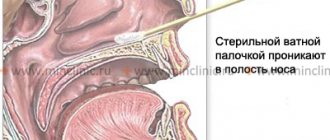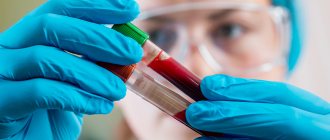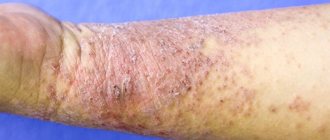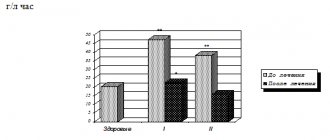Androgen levels in women with symptoms of hyperandrogenism may be within normal limits. Therefore, hormone analysis alone cannot make a diagnosis, much less build a treatment strategy. Hyperandrogenism is indicated, first of all, by the symptoms that make up the clinical picture of the disease. They are divided into three main groups:
- cosmetic defects;
- gynecological diseases;
- violation of metabolic processes.
External or cosmetic manifestations of the disease appear as:
- acne;
- seborrhea;
- hirsutism (male pattern hair growth);
- alopecia (loss of scalp hair).
Gynecological diseases arising against the background of hyperadrogenism:
- menstrual disorders and anovulation;
- endometrial hyperplasia;
- infertility;
- polycystic ovary syndrome.
Metabolic disorders due to hyperandrogenism:
- type 2 diabetes mellitus;
- hyperlipoproteinemia;
- upper body obesity.
Hyperandrogenism in women
What is hyperandrogenism? According to ICD 10, hyperandrogenism (international classification of diseases, ICD code E28.1) is a condition in which the body produces an excess amount of androgens (male sex hormones). This disease can also be referred to as hirsutism - this is male pattern hair growth in women and children. Hyperandrogenism occurs due to the development of certain diseases and syndromes, mainly associated with dysfunction of organs that produce hormones.
With an increase in androgens in the blood of women, they begin to exhibit some masculine characteristics (deepening of the voice, abundant hair on some parts of the body). If hyperandrogenism in women is left untreated for a long time, it can lead to infertility.
Hyperandrogenism in women is very rarely asymptomatic, so you should be attentive to changes in your body and the appearance of unwanted hair.
There are several types of this disease:
- ovarian origin - symptoms appear unexpectedly, arise due to a disorder in the ovaries, in which androgens are not converted into estrogens (female sex hormones) under the action of enzymes (often the cause of this dysfunction is tumors in the ovarian zone or polycystic ovaries);
- hyperandrogenism of adrenal origin - can be asymptomatic for a very long time, moving into more severe stages. Most often it develops due to genetic characteristics or a tumor of the adrenal glands, provoked by stressful situations, changes in hormonal levels during pregnancy, etc.;
- mixed genesis - combines disturbances in the functioning of the ovaries and adrenal glands, is the most complex form of hyperandrogenism, since the cause of this condition is disturbances in the functioning of the hypothalamus and neuroendocrine disorders;
- transport - occurs when it is impossible to bind sex hormones due to a lack of globulin;
- central and peripheral - occurs due to disturbances in the functioning of the pituitary gland and hypothalamus, the formation of the hormone FSH, which is involved in the formation of estrogens from androgens, is disrupted, as a result of an increase in androgens and suppression of estrogens.
Causes of hyperandrogenism
Factors leading to the development of hyperandrogenism are:
- genetic predisposition (usually manifests itself in the first years of life);
- dysfunction of organs that produce sex hormones (the pituitary gland and hypothalamus may not work correctly, and this directly affects the functioning of the ovaries and the entire hormonal system);
- With insulin resistance syndrome;
- abnormal development of the adrenal cortex;
- with neoplasms on the ovaries and adrenal glands, an excessive amount of androgens (male sex hormones) is formed;
- PCOS (polycystic ovary syndrome);
- pituitary tumor (a tumor in this part of the brain provokes excessive formation of the hormone prolactin);
- taking steroid hormones;
- in the absence of menstruation in women, the hormonal balance is disrupted and can cause hyperandrogenism;
- pathologies of the thyroid gland;
- pathologies of the biliary tract;
- chronic liver and kidney diseases;
- uncontrolled or incorrect use of oral contraceptives;
- low level of globulin in the blood;
- proliferation of ovarian tissue.
To diagnose hyperandrogenism and determine the causes, a thorough diagnosis of the patient’s body is necessary.
Symptoms
Signs of pathology, depending on the cause that caused it, have varying degrees of severity. In many cases, hyperandrogenism develops extremely slowly and may not be clearly expressed (for example, with polycystic ovary syndrome). The main signs of a violation include:
- acne, acne;
- oily scalp, subject to personal hygiene rules;
- irregular menstrual cycle or lack thereof;
- excess hair on the face (mustache, beard, sideburns), arms, back, etc.;
- one of the manifestations of hyperandrogenism in women can be infertility;
- underdeveloped mammary glands;
- deepening of the voice in women;
- late onset of first menstruation.
Diagnosis of hyperandrogenism
The doctor will be able to diagnose hyperandrogenism based on the patient’s medical history and instrumental studies of the body.
The specialist knows that this pathology can have different manifestations at different ages, so he will ask many questions and carefully analyze the answers to them:
- how long ago the patient noticed hirsutism (excess body hair);
- hair growth rate;
- duration of the menstrual cycle, their nature, pain, frequency;
- in which places on the body there is an excess of hair (chest, back, hips, stomach, etc.);
- development of secondary sexual characteristics;
- the quality of the patient’s body, whether there is excess weight, where the greatest accumulation of fat occurs;
- what medications were taken, hormonal therapy.
Based on the data received from the patient, the doctor may prescribe the following options for examining the body:
- taking a blood test to determine the concentration of various hormones in it (testosterone, luteinizing hormone, follicle-stimulating hormone, estradiol, cortisol, progesterone, etc.);
- A genetic blood test may be taken to identify hereditary mutations;
- taking a urine test to determine androgens and their traces;
- ultrasound examination of the pelvic organs and adrenal glands or MRI of these organs.
It is worth paying special attention to all diagnostic procedures prescribed by a doctor, since there are often cases when, with normal levels of hormones in the blood or with a normal state of organs, hyperandrogenism may be present on ultrasound. In such cases, pathology can only be seen based on many indicators.
Prevention
By following simple rules throughout your life, you can prevent the occurrence of adrenal hyperandrogenism or any other type.
Basic preventive measures:
- annual visit to a gynecologist;
- minimizing stressful situations (emotional as well as physical);
- do not abuse smoking, drugs, intoxicants, or alcohol;
- rich diet (fiber, protein, healthy fats without excessive carbohydrates, spicy foods, fried foods, etc.);
- start treatment of diseases in a timely manner to avoid complications and not affect other organs and systems.
Causes of the disease
Both the ovaries and the adrenal glands can produce excess androgens. In addition, excess androgens can appear as a result of metabolic disorders.
Adrenogenital syndrome is the most common cause of an increased amount of male sex hormones.
Hyperandrogenism is congenital, or this disease occurs due to diseases (including tumors) of the pituitary gland, which is the main endocrine gland located in the brain. In the presence of neuroendocrine syndrome (dysfunction of the pituitary gland and hypothalamus), signs of hyperandrogenism are accompanied by a significant increase in body weight.
In addition, the cause of the disease may be the presence of an adrenal tumor. As the number of cells that produce androgens increases, the number of these hormones also increases significantly.
Treatment of hyperandrogenism syndrome
Since hyperandrogenism is not an independent disease, but occurs against the background of another pathology, treatment has an integrated approach.
According to clinical recommendations, depending on the cause of the disease, associated factors and the severity of symptoms, treatment is carried out in conjunction with eliminating the root cause or sequentially.
Drug treatment
Drugs are used that are designed to reduce the production of male sex hormones androgens:
- hormonal preparations containing progesterone;
- drugs that inhibit the production of androgens in the adrenal glands and ovaries;
- drugs that stimulate greater formation of female hormones estrogen.
Treatment of concomitant diseases
In order for therapy to give a real result that will not disappear soon, it is imperative to eliminate the root cause. These could be diseases of the thyroid gland and liver, the presence of hormone-producing neoplasms, etc.
To treat concomitant diseases, certain medication therapy or surgical intervention (removal of tumors, cysts, etc.) may be sufficient.
Lifestyle with hyperandrogenism
Any treatment must be accompanied by reflection on your lifestyle and daily habits.
Our diseases today are most often a consequence of our actions in the past.
For treatment to be effective it is necessary:
- bring the body to normal weight;
- physical exercise;
- balanced diet.
Forecast
If you are attentive to your body and its health, then with timely treatment and the absence of congenital pathologies, you can talk about a successful cure.
Women who have successfully completed treatment and follow the recommendations of doctors in the future do not have complications of hyperandrogenism, and can also become pregnant and give birth to a healthy child. Usually, pregnancy planning in such cases, as well as the entire period of pregnancy, the patient is under the strict supervision of doctors.
Normal levels of androgens in human blood
Several androgens are detected in a woman's body. Thus, a woman’s normal testosterone level is 0.2-2.0 ng/ml, cortisol is from 190 to 750 ng/ml, and aldosterone is no more than fifteen nanograms per milliliter. The level of progesterone and estradiol changes depending on the phase of the cycle. So, in the follicular phase, estradiol should be 0.17, and progesterone 1.59 nmol/l. During ovulation, their concentration increases to 1.2 and 4.77 nmol/l, respectively. In the luteal phase, the amount of these hormones is maximum: estradiol 0.57, and progesterone 29.6 mol/ml.
Which doctor should I contact?
If you notice signs of hyperandrogenism or you need specialist advice on this issue, you should first contact an endocrinologist, and after understanding your problem and studying your medical history, he will prescribe additional examinations, if necessary.
One of the specialists in endocrinology is Georgy Nikitich Romanov, who has been practicing medicine for more than 20 years. Georgy Romanov studied not only in Belarus, but also in Russia and some European countries (Great Britain, Germany), and practices modern methods of diagnosis and treatment. An individual approach to each patient, since only a thorough study of the patient’s medical history allows us to find the root cause of the disease and prescribe effective treatment. Provides consultations and closely monitors the progress of treatment.
In addition to the fact that endocrinologist Georgy Nikitich Romanov practices in Gomel, he also consults patients online.
You can sign up for an online consultation in any messenger or social network convenient for you: skype, instagram, viber, telegram, whatsapp or vkontakte.
If you are looking for an experienced, attentive specialist to identify hyperandrogenism in women or adolescents, as well as effective treatment of the disease, then they will help you here.
Our advantages
Highly qualified personnel
Successful treatment of hyperandrogenism is carried out by gynecologists-endocrinologists with many years of practice (up to 30 years), doctors of the highest category, candidates of medical sciences, participants in specialized congresses, and authors of published works in scientific journals.
Own clinical diagnostic laboratory
At the first signs of hyperandrogenism, doctors prescribe tests for sex hormones, a test with dexamethasone, etc. Each NEARMEDIC clinic has a treatment room for taking samples. They are processed in NEARMEDIC's own laboratory. The system for conducting research and issuing results is almost completely automated, which reduces the likelihood of error to a minimum. At the patient's request, test results can be sent to his email.
Hystersalpingography
Hysterosalpingography is a study of the uterine cavity and fallopian tubes using a contrast agent and x-rays. Hystersalpingography is performed using a catheter, which is inserted into the cervix. A contrast agent is injected through the catheter, and the distribution of the contrast agent is monitored using a fluoroscope. In this way, adhesions and obstruction of the fallopian tubes are detected. Hysterosalpingography allows you to assess the condition of the uterine cavity and fallopian tubes, the presence of adhesions. To examine the ovaries and other pelvic organs, you should undergo additional studies using MRI and ultrasound. Hysterosalpingography is prescribed when examining for infertility.









